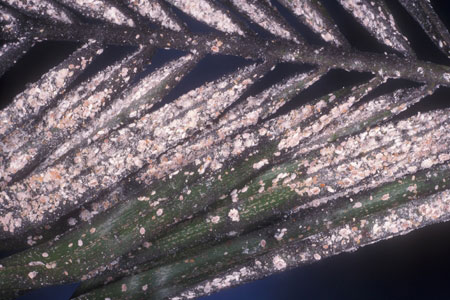Home » Bugs » Lawn Pests »
Active Seasons



Coconut Mealybug Appearance and Size Facts
With the ability to damage common Florida trees such as palms and other tropical plants, coconut mealybugs are a nuisance no homeowner should have to deal with. But if you find yourself dealing with an infestation, there’s no need to wave the white flag. Let our team at Hulett Environmental Services guide you through information on how to identify and remove your potential or existing coconut mealybug infestation.
To start, here are some common characteristics of the average coconut mealybug:
- Body: Females are oval-shaped, while males are oblong.
- Size: Females range from 1/18 to 1/10 of an inch in length. Males are significantly smaller.
- Covering: Each coconut mealybug is protected under a wax covering with five to eight pyramid-shaped filaments coming out.
- Color: The actual mealybug is reddish-brown.
Distinguishing Coconut Mealybugs From Other Lawn Pests
In appearance, the main way to differentiate coconut mealybugs from similar lawn pests is their pyramid-shaped filaments. It will make them appear as if they have spikes coming out of their wax covering. However, it can be a challenge determining your infestation on your own. You can always turn to professional pest control services for help identifying infestations on residential and commercial properties.
We provide pest control for coconut mealybugs in the following locations and their surrounding areas:

Behavior and Habitat of Coconut Mealybugs
The average life span of a coconut mealybug, from egg to adulthood, ranges from one to two months. Early in life, males and females look the same. Before reproduction as adults, the males come out of their wax covering and emerge in winged form. Females, on the other hand, remain in their wax-cocooned form.
As for their habitat, coconut mealybugs feed on a variety of host plants, such as palms, banana trees, citrus plants, and other tropical plant life. Being in a more humid and tropical environment, Florida homeowners should be on the lookout for any coconut mealybugs trying to feed on the plants in and around their homes.

Signs of Infestation of Coconut Mealybugs
Similar to other lawn pests and scale insects, coconut mealybugs feed on plant juices. Their excrement results in a mold that leads to a reduction of plant photosynthesis, leaf drop, and on rare occasions, death. Another sign of a coconut mealybug infestation is the increased presence of ants, which they can attract through honeydew secretions.

Tips for Prevention of Coconut Mealybugs
If you think you have a coconut mealybug problem, use water to wash away the insects from the host plant. When a larger population starts to develop, you may need professional grade products to get control, and your best course of action will be to find professional pest control services for help.
Getting Rid of Coconut Mealybugs
Preventive measures can help decrease your odds of getting a coconut mealybug infestation. However, they are not a replacement for proper pest control. Similar to other pests, professional coconut mealybug control services, such as the ones offered by Hulett, are the most effective solution for protecting your south Florida home and yard from an infestation.
Effective Coconut Mealybug Control Solutions
When you need the most effective coconut mealybug control services in Florida, just call Hulett! With over 50 years of experience, we offer green and preventive treatments that deal no harm to you and your loved ones but are super effective in removing your pest problem. Schedule your free inspection online or give us a call to begin today!

